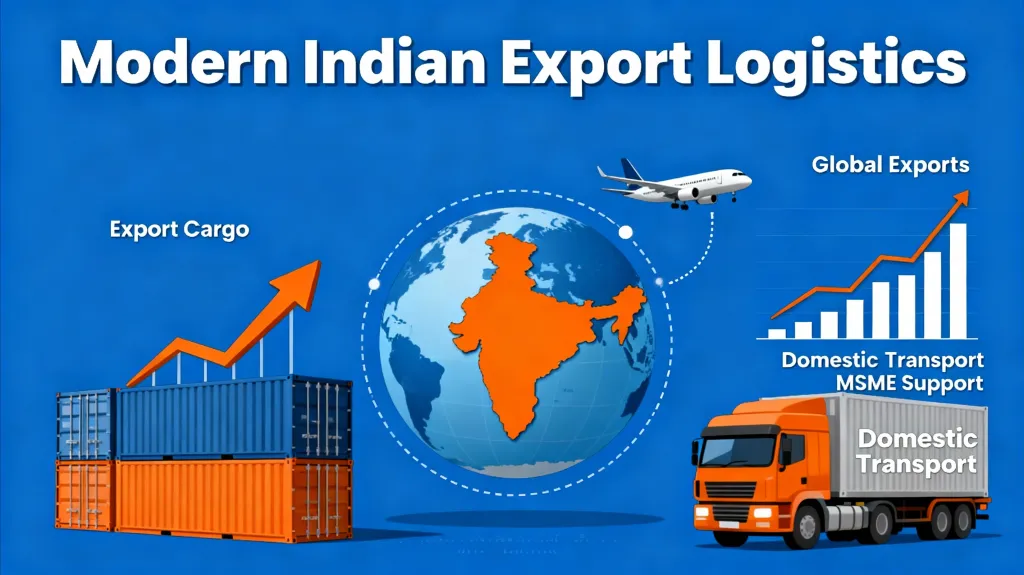Government Greenlights ₹45,060 Crore Support Package to Power Indian Exports

The Export Promotion Mission (EPM) and allied schemes, with a combined outlay of ₹45,060 crore, aim to strengthen India’s export ecosystem at a time of global headwinds.
Key Components
The core of the package is the Export Promotion Mission (EPM), with an allocation of ₹25,060 crore over six financial years (starting FY 2025-26 through FY 2030-31).
The EPM will operate via two flagship sub-schemes:
“Niryat Protsahan”: Focused on trade finance, interest subvention, export factoring, credit cards for e-commerce exporters, and collateral guarantees.
“Niryat Disha”: Geared towards non-financial enablers such as export quality & compliance support, branding/packaging, trade fairs, warehousing & logistics, and trade intelligence.
Alongside EPM, a Credit Guarantee Scheme for Exporters (CGSE) has been approved, with further support of up to ₹20,000 crore earmarked to provide 100 % credit guarantee coverage for banks providing additional collateral-free loans to eligible exporters (particularly MSMEs).
Why Now?
Indian exporters are facing serious external pressures, including steep tariffs in key markets.
MSMEs and first-time exporters - often constrained by access to trade finance, certification/compliance cost burdens, and weak brand visibility abroad - stand to benefit the most under the new framework.
The scheme consolidates previously fragmented export-support programmes (such as the Market Access Initiative, Interest Equalisation Scheme) into a more coherent, digitally-enabled architecture.
What It Will Do
Improve affordable access to trade finance, especially for MSMEs.
Strengthen export readiness via support for compliance, quality certification, packaging & branding for international markets.
Enhance market diversification into new geographies, reducing over-dependence on traditional markets.
Target labour-intensive export sectors such as textiles, leather, gems & jewellery, engineering goods and marine products.
Deploy a digitally managed application and disbursal platform, integrating with existing trade systems under the Directorate General of Foreign Trade (DGFT).
Challenges & Watch-Points
One think-tank noted that while the framework is welcome, swift rollout depends on clarity of guidelines, timely funding and coordination across ministries and states.
The annual per-year outlay from the ₹25,060 crore total works out to under ~₹4,200 crore per year on average-some analysts say this may be stretched given the wide scope of support required.
Execution risk: the success will depend on how well the sub-schemes are implemented, how easily exporters can access benefits, whether MSMEs can truly tap the credit and compliance support.
Monitoring real impact: measuring how much this boosts exports, generates jobs, reduces export attrition, and diversifies market destinations will be key.
Broader Implications
From a strategic standpoint, this package aligns with the government’s push for an “Atmanirbhar Bharat” (self-reliant India) and “Make in India for the world” narrative - by enabling Indian exporters to compete globally.
Given the current global trade volatility (tariffs, supply-chain disruptions, shifting sourcing patterns), the move signals India’s intent to be proactive rather than reactive.
For MSMEs especially, easier access to trade finance + non-financial support could help unlock latent export potential in non-traditional districts and sectors.
Final Word
This ₹45,060 crore export-support package is a big policy push - both symbolic and substantive. It marks a transition from reactive, fragmented support to a more forward-looking, integrated export-ecosystem strategy. But as with any large programme, the real story will be in implementation - how smoothly exporters can tap the benefits, how decisively markets diversify, how effective the oversight and digital platforms prove to be. For now, Indian exporters have a stronger policy backing; whether it becomes a genuine game-changer remains to be seen.







